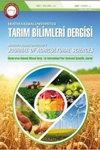无苦味胡玛橄榄(Erkence cv.)的营养价值研究
IF 1.1
4区 农林科学
Tarim Bilimleri Dergisi-journal of Agricultural Sciences
Pub Date : 2016-12-12
DOI:10.15832/tbd.08465
引用次数: 2
摘要
Hurma橄榄(Olea europea L.)是一种众所周知的产品,它是由于Erkence橄榄品种的果实中发生的脱苦味而形成的,当橄榄还在树上时,它就会去除苦味,从而使橄榄可食用。“脱啤”是指橄榄果实还挂在树上时的成熟期。在这项研究中,目的是收获来自卡拉布伦半岛不同地点的Hurma橄榄,以确定其营养价值。为此,对样品进行了测量,以确定它们的油(%)、蛋白质(%)、总糖(%)、还原糖(%)、淀粉(%)、能量(kcal 100 g-1)、pH、总酚类化合物(mg咖啡酸当量(CAE) 100 g-1)、矿物元素(N、P、K、Ca、mg、Fe、Mn、Zn、Cu、B)含量。此外,还比较了从半岛三个不同地点收集的新收获的Hurma橄榄和储存了1年的干盐橄榄的一些化学性质。测定乌玛橄榄的含油量为38.63%,蛋白质为1.2%,总糖为0.52%,淀粉为1.24%,pH值为5.52。由于含有相当高的油(359.8千卡100克-1)、酚类化合物(288.71毫克CAE 100克-1)和矿物元素含量,它们被认为是一种很好的能量来源。结果表明,Hurma橄榄矿质元素含量较高(N 0.57%、P 0.12%、K 1.42%、Ca 0.09%、Mg 0.04%、Fe 61.44 Mg kg-1、Mn 5.23 Mg kg-1、Zn 6.40 Mg kg-1、Cu 5.53 Mg kg-1、B 21.27 Mg kg-1)。施盐对橄榄样品酚类化合物和还原糖含量的影响无统计学意义(P>0.05)。根据所获得的结果,食用胡尔玛橄榄可能被认为对人体健康有益,因为它的无盐成分、营养化合物、总酚化合物含量和它提供的能量。本文章由计算机程序翻译,如有差异,请以英文原文为准。
A Study on the Nutritional Value of Hurma Olives (Erkence cv.) that Lose the Bitterness on the Tree
Hurma olive (Olea europea L.) is known to be a product that is formed as a result of debittering that occurs in the fruits of Erkence olive cultivars leading the removal of the bitter taste in the olive when it is still on the tree and thus making the olive edible. “Debittering” is the term expressed as the maturation period occurring in the olive fruit while it is still on the tree. In this study, the aim was to harvest Hurma olives from different locations of the Karaburun peninsula in order to determine the nutritional value. For this purpose, measurements were carried out on samples in order to determine their oil (%), protein (%), total sugars (%), reduced sugar (%), starch (%), energy (kcal 100 g-1), pH, total phenolic compound (mg cafeic acid equivalent (CAE) 100 g-1), mineral element (N, P, K, Ca, Mg, Fe, Mn, Zn, Cu, B) contents. Besides, new harvested Hurma olives and dry salted ones stored for 1 year, that had been collected from three different locations of the peninsula, were compared in terms of some chemical properties. Hurma olives were determined to have 38.63% oil, 1.2% protein, 0.52% total sugar, 1.24% starch and the pH value of 5.52. They are regarded as a good source of energy due to the considerably higher oil (359.8 kcal 100 g-1), phenolic compounds (288.71 mg CAE 100 g-1) and mineral element content. It was found out that Hurma olives had high values in terms of mineral element content (N 0.57%, P 0.12%, K 1.42%, Ca 0.09%, Mg 0.04%, Fe 61.44 mg kg-1, Mn 5.23 mg kg-1, Zn 6.40 mg kg-1, Cu 5.53 mg kg-1, B 21.27 mg kg-1) as well. The effects of the salt applications on phenolic compound and reduced sugar content of the olive samples was found statistically insignificant (P>0.05). According to the results obtained, the consumption of Hurma olive might be considered to be beneficial for human health due to its salt-free composition, nutritive compounds, total phenolic compound content and the amount of energy it provides.
求助全文
通过发布文献求助,成功后即可免费获取论文全文。
去求助
来源期刊
CiteScore
1.40
自引率
0.00%
发文量
26
期刊介绍:
Journal of Agricultural Sciences (JAS) is an international, double-blind peer-reviewed, open-access journal, published by the Faculty of Agriculture, Ankara University. The journal invites original research papers containing new insight into any aspect of Agricultural Sciences that are not published or not being considered for publication elsewhere. Preliminary, confirmatory or inconclusive research, review articles, case and local studies and works presenting taxonomy will not be published.

 求助内容:
求助内容: 应助结果提醒方式:
应助结果提醒方式:


